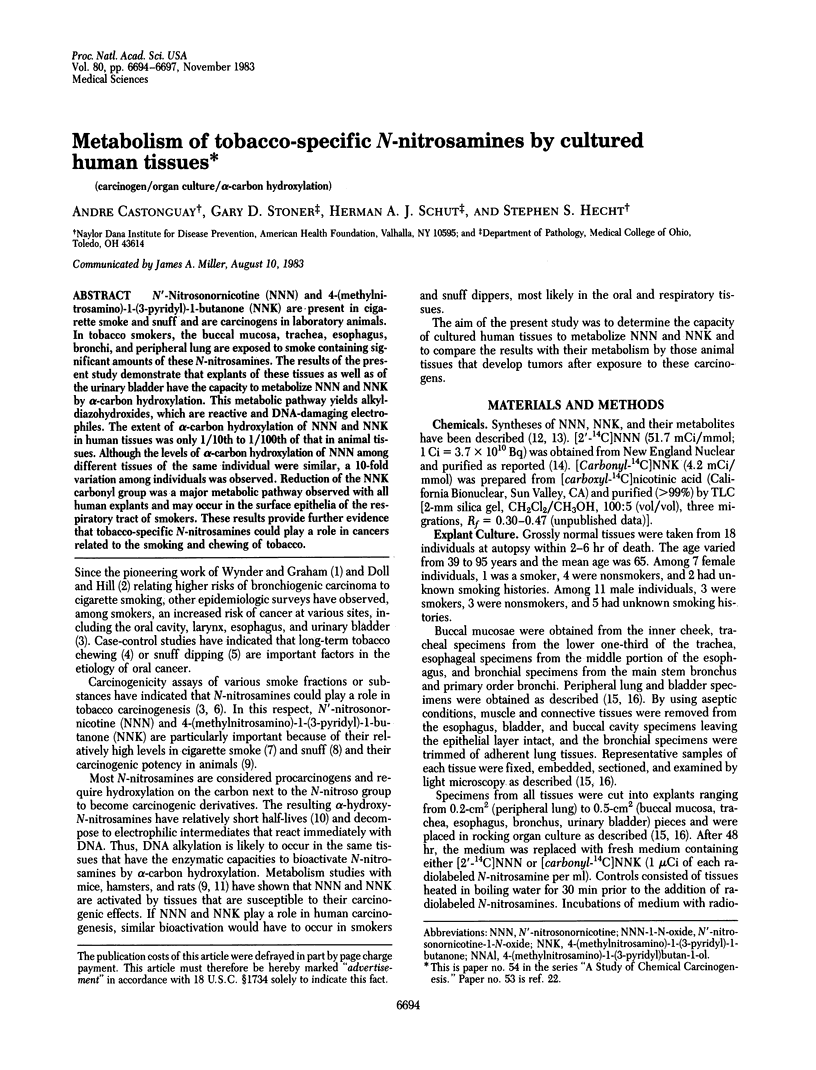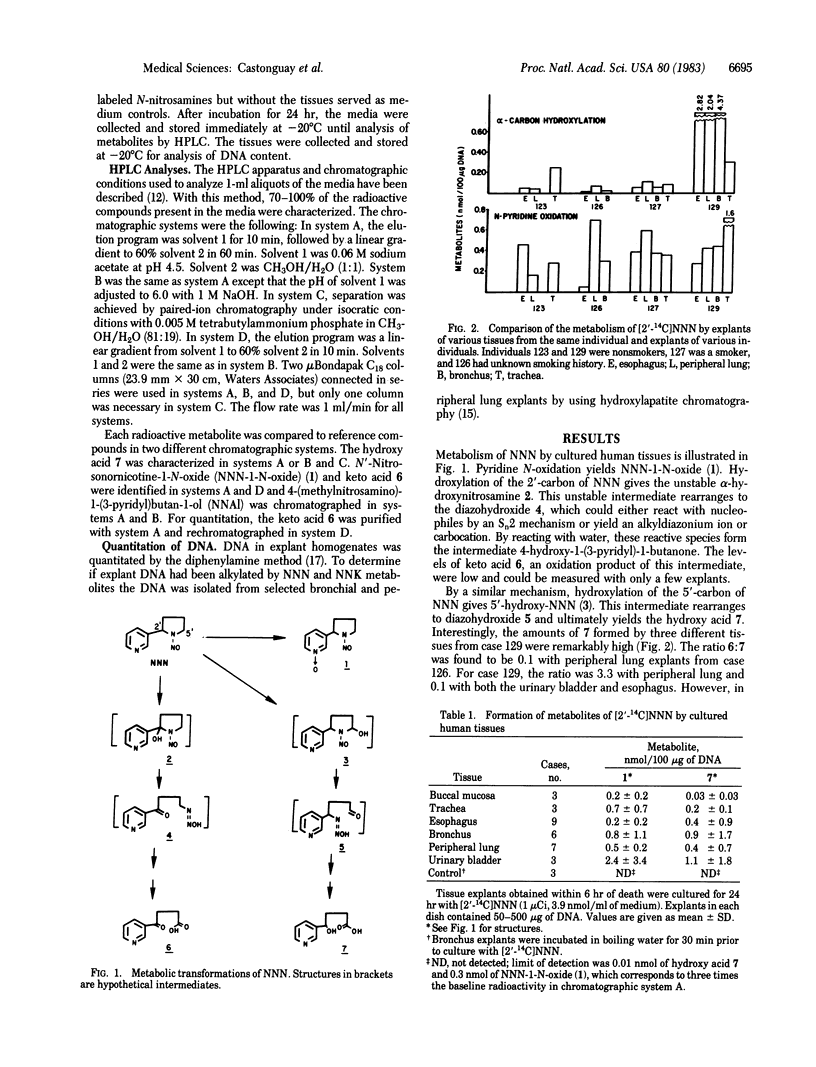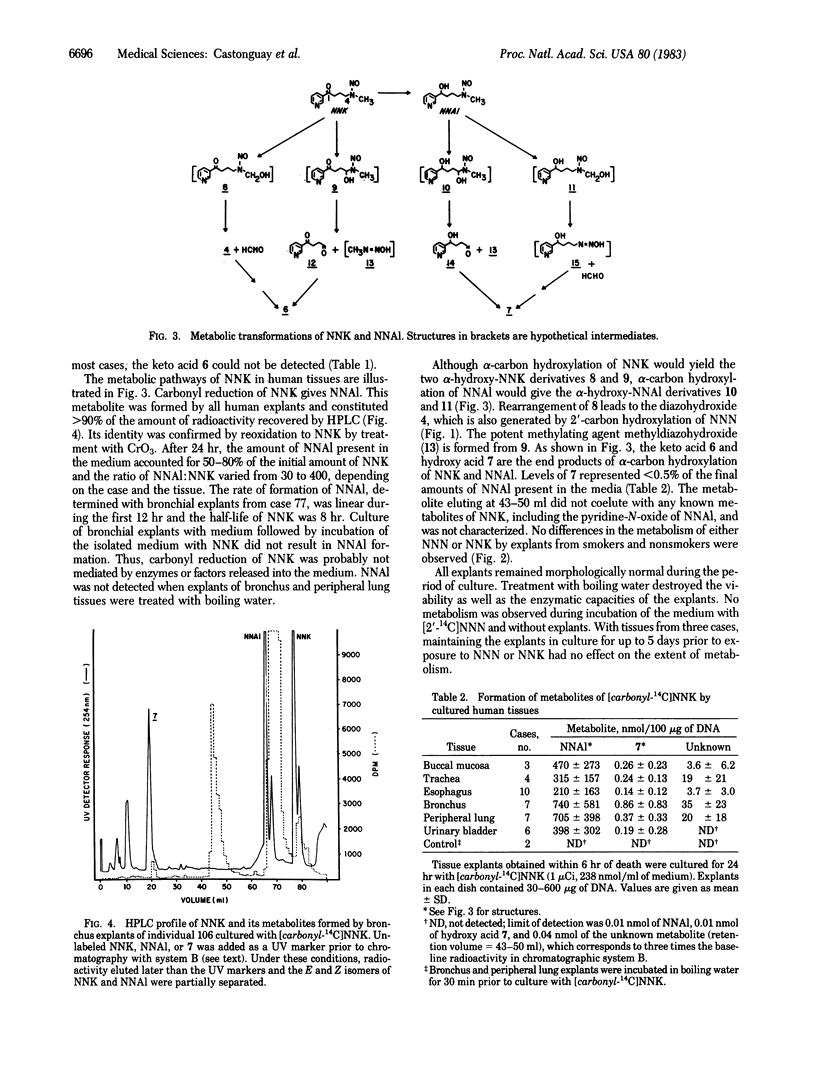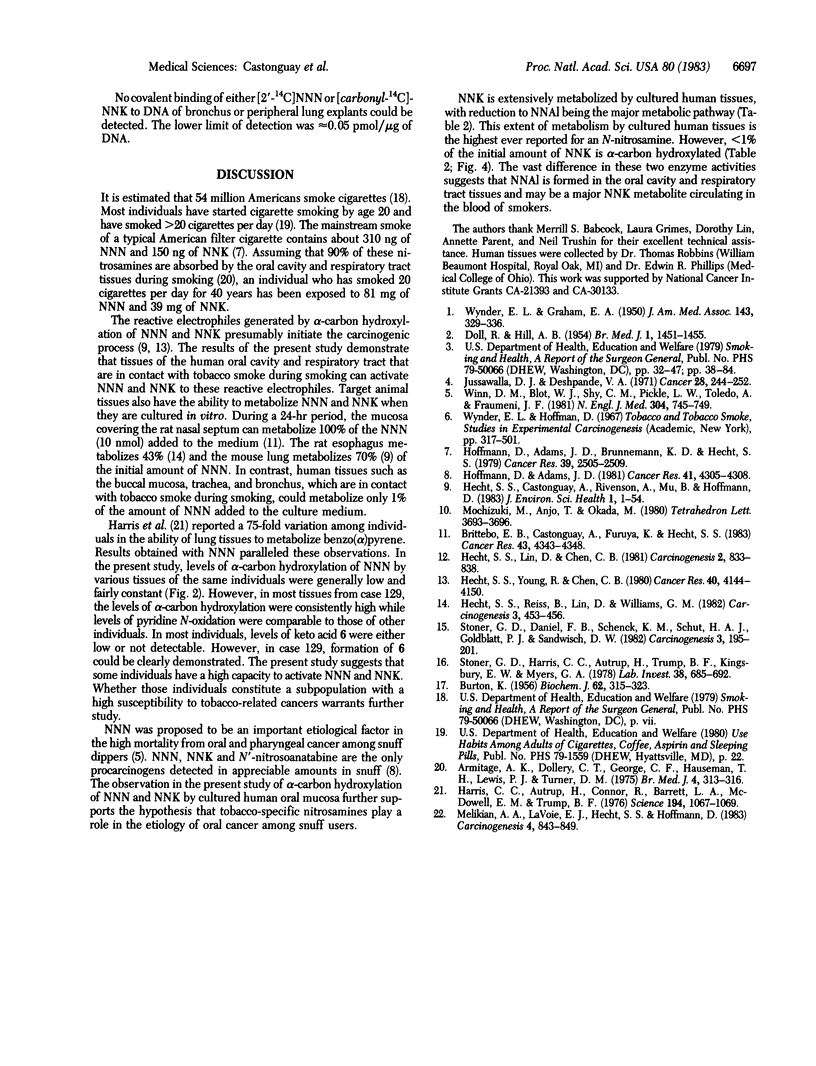Abstract
N'-Nitrosonornicotine (NNN) and 4-(methylnitrosamino)-1-(3-pyridyl)-1-butanone (NNK) are present in cigarette smoke and snuff and are carcinogens in laboratory animals. In tobacco smokers, the buccal mucosa, trachea, esophagus, bronchi, and peripheral lung are exposed to smoke containing significant amounts of these N-nitrosamines. The results of the present study demonstrate that explants of these tissues as well as of the urinary bladder have the capacity to metabolize NNN and NNK by alpha-carbon hydroxylation. This metabolic pathway yields alkyldiazohydroxides, which are reactive and DNA-damaging electrophiles. The extent of alpha-carbon hydroxylation of NNN and NNK in human tissues was only 1/10th to 1/100th of that in animal tissues. Although the levels of alpha-carbon hydroxylation of NNN among different tissues of the same individual were similar, a 10-fold variation among individuals was observed. Reduction of the NNK carbonyl group was a major metabolic pathway observed with all human explants and may occur in the surface epithelia of the respiratory tract of smokers. These results provide further evidence that tobacco-specific N-nitrosamines could play a role in cancers related to the smoking and chewing of tobacco.
Full text
PDF



Selected References
These references are in PubMed. This may not be the complete list of references from this article.
- Armitage A. K., Dollery C. T., George C. F., Houseman T. H., Lewis P. J., Turner D. M. Absorption and metabolism of nicotine from cigarettes. Br Med J. 1975 Nov 8;4(5992):313–316. doi: 10.1136/bmj.4.5992.313. [DOI] [PMC free article] [PubMed] [Google Scholar]
- BURTON K. A study of the conditions and mechanism of the diphenylamine reaction for the colorimetric estimation of deoxyribonucleic acid. Biochem J. 1956 Feb;62(2):315–323. doi: 10.1042/bj0620315. [DOI] [PMC free article] [PubMed] [Google Scholar]
- Brittebo E. B., Castonguay A., Furuya K., Hecht S. S. Metabolism of tobacco-specific nitrosamines by cultured rat nasal mucosa. Cancer Res. 1983 Sep;43(9):4343–4348. [PubMed] [Google Scholar]
- DOLL R., HILL A. B. The mortality of doctors in relation to their smoking habits; a preliminary report. Br Med J. 1954 Jun 26;1(4877):1451–1455. doi: 10.1136/bmj.1.4877.1451. [DOI] [PMC free article] [PubMed] [Google Scholar]
- Harris C. C., Autrup H., Connor R., Barrett L. A., McDowell E. M., Trump B. F. Interindividual variation in binding of benzo[a]pyrene to DNA in cultured human bronchi. Science. 1976 Dec 3;194(4269):1067–1069. doi: 10.1126/science.982061. [DOI] [PubMed] [Google Scholar]
- Hecht S. S., Lin D., Chen C. B. Comprehensive analysis of urinary metabolites of N'-nitrosonornicotine. Carcinogenesis. 1981;2(9):833–838. doi: 10.1093/carcin/2.9.833. [DOI] [PubMed] [Google Scholar]
- Hecht S. S., Reiss B., Lin D., Williams G. M. Metabolism of N'-nitrosonornicotine by cultured rat esophagus. Carcinogenesis. 1982;3(4):453–456. doi: 10.1093/carcin/3.4.453. [DOI] [PubMed] [Google Scholar]
- Hecht S. S., Young R., Chen C. B. Metabolism in the F344 rat of 4-(N-methyl-N-nitrosamino)-1-(3-pyridyl)-1-butanone, a tobacco-specific carcinogen. Cancer Res. 1980 Nov;40(11):4144–4150. [PubMed] [Google Scholar]
- Hoffmann D., Adams J. D., Brunnemann K. D., Hecht S. S. Assessment of tobacco-specific N-nitrosamines in tobacco products. Cancer Res. 1979 Jul;39(7 Pt 1):2505–2509. [PubMed] [Google Scholar]
- Hoffmann D., Adams J. D. Carcinogenic tobacco-specific N-nitrosamines in snuff and in the saliva of snuff dippers. Cancer Res. 1981 Nov;41(11 Pt 1):4305–4308. [PubMed] [Google Scholar]
- Jussawalla D. J., Deshpande V. A. Evaluation of cancer risk in tobacco chewers and smokers: an epidemiologic assessment. Cancer. 1971 Jul;28(1):244–252. doi: 10.1002/1097-0142(197107)28:1<244::aid-cncr2820280150>3.0.co;2-h. [DOI] [PubMed] [Google Scholar]
- Melikian A. A., LaVoie E. J., Hecht S. S., Hoffmann D. 5-Methylchrysene metabolism in mouse epidermis in vivo, diol epoxide--DNA adduct persistence, and diol epoxide reactivity with DNA as potential factors influencing the predominance of 5-methylchrysene-1,2-diol-3,4-epoxide--DNA adducts in mouse epidermis. Carcinogenesis. 1983;4(7):843–849. doi: 10.1093/carcin/4.7.843. [DOI] [PubMed] [Google Scholar]
- Stoner G. D., Daniel F. B., Schenck K. M., Schut H. A., Goldblatt P. J., Sandwisch D. W. Metabolism and DNA binding of benzo[a]pyrene in cultured human bladder and bronchus. Carcinogenesis. 1982;3(2):195–201. doi: 10.1093/carcin/3.2.195. [DOI] [PubMed] [Google Scholar]
- Stoner G. D., Harris C. C., Autrup H., Trump B. F., Kingsbury E. W., Myers G. A. Explant culture of human peripheral lung. I. Metabolism of benzo[alpha]pyrene. Lab Invest. 1978 Jun;38(6):685–692. [PubMed] [Google Scholar]
- WYNDER E. L., GRAHAM E. A. Tobacco smoking as a possible etiologic factor in bronchiogenic carcinoma; a study of 684 proved cases. J Am Med Assoc. 1950 May 27;143(4):329–336. doi: 10.1001/jama.1950.02910390001001. [DOI] [PubMed] [Google Scholar]
- Winn D. M., Blot W. J., Shy C. M., Pickle L. W., Toledo A., Fraumeni J. F., Jr Snuff dipping and oral cancer among women in the southern United States. N Engl J Med. 1981 Mar 26;304(13):745–749. doi: 10.1056/NEJM198103263041301. [DOI] [PubMed] [Google Scholar]


